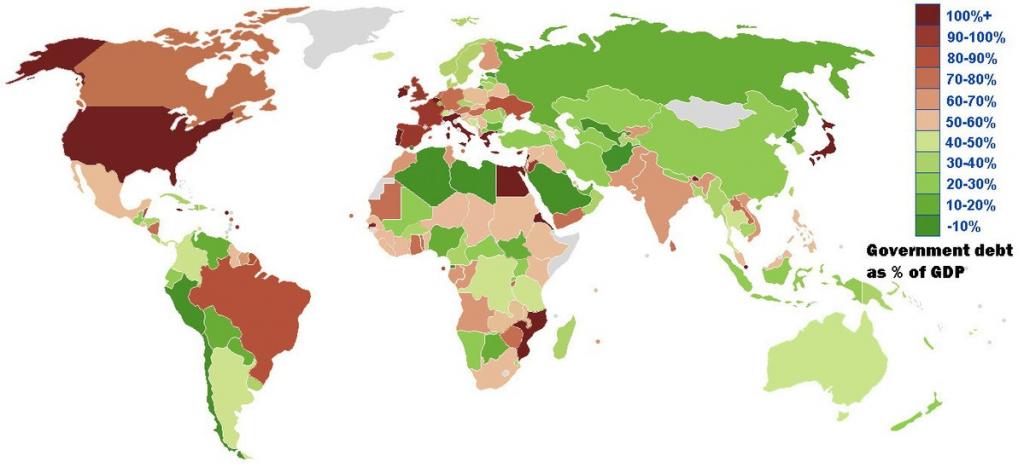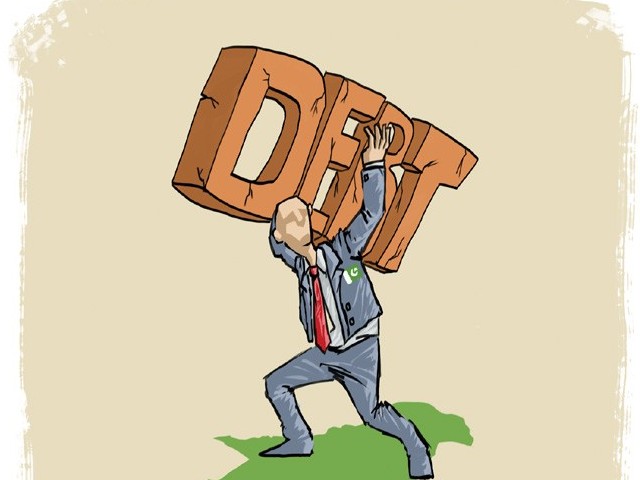Since the 19th century, borrowing has been seen as an important source of revenue for almost all democratic governments.
It is an alternative way to increase revenue. This is the means by which public spending is financed in the event of a budget deficit.
Nowadays, borrowing from governments has become the usual method of public financing.

Fig. 1 The ratio of public debt to GDP in different countries.
External and internal debt
The government can take loans from banks, organizations and private individuals within the country or from international institutions and foreign states during emergencies.
Loans received domestically are called internal debt, loans from other states or international funds - external debt.
For the use of borrowed funds, the government pays interest to creditors at fixed rates at regular intervals or at the end of the period, in addition to the principal amount.
Use of borrowed funds
Resources raised in the form of public debt can be used for various purposes.
1. Covering the budget deficit
Government borrowing is used to eliminate the budget deficit. Modern governments do not have large accumulated cash balances. The budget deficit is the reality of our time in almost all countries. The principle of financial management insists that government annual expenses should be covered from annual income. But due to various circumstances, profits from tax and non-tax sources may be less than actual expenses. In such circumstances, short-term loans in anticipation of tax collection are used by the government to bridge budget gaps.

2. Disaster management
Floods, earthquakes, and other natural disasters can also create budget gaps. Large external debts arise in warring countries. Modern contention is an expensive affair. During the war, all the resources available to the government may not be sufficient to cover the enormous military costs.
The introduction of additional taxes or raising rates beyond certain limits has disastrous consequences for the economy. Therefore, the government attracts external loans to cover military spending.
3. The fight against inflation and unemployment
Depression and unemployment are usually caused by a deficit in effective demand as a result of low economic activity.
The increase in government spending financed by loans is used to create and maintain development projects to mitigate the effects of economic crises.Keynes advocated an increase in government spending financed by borrowing rather than taxation as the best way to deal with depression.

4. Acceleration of economic development
The development of an economy experiencing a capital shortage usually depends on borrowed funds to finance various projects and increase the productive capacity of the economy.
Such investments strengthen the production base and increase the production of goods and services. In the future, the state will be able to raise funds without special difficulties for servicing and paying off state debt at the expense of income received as a result of economic growth.
5. Financing social projects
Government debt is used to finance, create and develop social projects - education and health, which cannot be covered by a conventional source, such as taxation.
Service and repayment of public debt
Repayment of loans or failure to do so is a kind of check of the unplanned nature of government spending.
In the same way that an individual is responsible for paying off his personal debt, states are obliged to repay the loans they have taken. The government must find the necessary resources to fulfill its loan obligations.
The accumulated large volume of the country's financial obligations has a demoralizing effect on the population, in addition to the tax burden imposed on it in connection with servicing and paying off public debt.

Loan repayment methods
For settlements with creditors, the state has the opportunity to apply the following methods:
- rejection of public debt;
- return;
- conversion or conversion;
- redemption of debt obligations;
- inflation or currency expansion;
- repayment of serial bonds;
- terminal annuity;
- creation and use of accumulation funds.
Waiver of public debt
One easy way to relieve the burden of debt is to abandon it. The government refuses to repay the loan and pay interest. It is rather the destruction of debt, rather than its repayment.
This is undesirable and is rarely practiced. Renunciation will undermine confidence in government. Countries that refuse to repay and service external public debt will lose their creditworthiness. And in the future, it will be very difficult for the state to obtain a loan at a reasonable interest rate in the international capital market.
It is also immoral, since the loan would be obtained from funds mobilized from all persons earning income in the community. However, in extreme cases, the government may be forced to abandon its internal or external debt obligations.
This measure in the history of credit relations between states was used by governments that came to power as a result of military coups, revolutions or liberation wars. After independence, the United States refused to pay the debts of England and Spain. Soviet Russia in 1917 - according to the internal and external obligations of the tsarist government.
Of all the methods for repaying and servicing public debt, failure is the most extreme measure.

Return
With this method, the old debt is repaid at the expense of new loans attracted by the government of the country upon maturity of the previous obligations or interest on them. A state that does not have the means to repay a debt issues new bonds on the same conditions and replaces them. This provides temporary relief from liabilities, does not worsen the country's credit rating and provides additional time to raise funds.
The costs of servicing the public debt in this case increase by the amount of the costs of issuing new securities.
Conversion, or Conversion
Conversion is also a return method. This is the process of exchanging old bonds for new ones. The goal in this case is to obtain any benefits under the new loan agreement. For example, a decrease in interest rates, a change in the payment schedule and other details.
Unlike repayment, conversion is actually a method of reducing the cost of servicing public debt.
Debt repurchase
The method consists in repurchasing government securities or operations in the open stock market.
If there is excess income, the country spends it on the purchase of its own government bonds from creditors. This method is widespread for bonds of domestic government debt, the service of which provides for the possibility of early repayment.

Inflation or currency expansion
The government can also pay off debt by issuing a new national currency or devaluing the old one. This method is possible to repay domestic government debt. But it has an extremely negative effect on the country's economy, creating an inflationary situation in it.
This way of eliminating domestic debt undermines the credit of government confidence. In the future, it will be difficult for him to borrow funds in the domestic capital market.
Repayment of serial bonds
This is a method in which a part is repaid each year from budget revenues in such a way that the total debt is eliminated over a certain period.
In accordance with this method, the government annually provides for the cancellation of a small part of the debt. This method becomes possible only if the government has a surplus budget. To carry out this repayment process, issued loans are issued in accordance with their repayment periods.
Terminal annuity
According to this method, annual budget expenditures for servicing public debt are planned. Redemption takes place in equal parts, which include both interest and the principal amount. This is also called the annual repayment method.

Creation of savings funds
Of the total state revenues, a certain part is transferred to specially created funds. The amount accumulated in them is used to pay off debt. This is the most systematic and best method of paying debt. Simply put, this is the creation and gradual accumulation of a fund that will be enough to:
1. Public debt services on a regular basis.
2. Full fulfillment of credit obligations within the agreed period.
Suppose the government issues government loan bonds for the construction of an oil refinery. These securities are redeemable in ten years. At the same time, a fund is being created to service public debt. Excise taxes on gasoline or part of them are accumulated in the fund account. During the construction of the plant, tax revenue with bank interest will be enough to pay off the initial debt.
This method is widely practiced in many countries of the world. One of its drawbacks is that during periods of financial crisis, the government can use the accumulated fund to spend funds for other purposes without hesitation.
Legal regulation
For over a century, public debt has been an integral part of the budgets of most countries. The legal regulation of relations between the country and its creditors is regulated by national laws. The servicing of the state debt of the Russian Federation is regulated by Article 119 of the Budget Code of the country.









